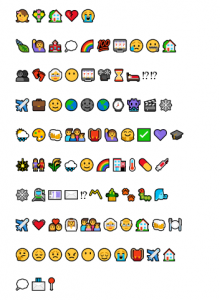I really enjoyed this task! I have always loved using emoji in my text messages, emails and even on Canvas discussion boards. I enjoy the advantages of using emoji because we are given the ability to present information in a variety of interesting ways (Kress, 2005). Personally, I believe that emoji express some forms of personalities to writings. However, I often found myself deleting some of the emoji that I use just in case others find them overwhelming. I also acknowledge the fact that not everyone fancy using emoji, especially after reading this article that talks about how people read emoji differently.
Emoji are also often used in my classroom setting. To teach words related to feelings, I ask students to practice making emotions with their own faces. But really, there are just so many different expressions they are able to make. I later discovered a useful article written by Colm Boyd, a material writer and an educator based in Barcelona. In this article, different ways to effectively use emoji in the classroom are discussed in detail. Using the suggested activities, I found using visual references such as emoji injects fun in learning besides helping students to use precise language in describing their own emotions or understanding lesson content without the need to find the right words. Also, with some students who tend to avoid (and hate) writing, encouraging them to plan their writing in emoji encourages them to take on the writing task in a fun manner.
Highlight here to find out the title of the : For this task, I immediately knew that the book I wanted to write about is a non-fiction book by Adeline Yen Mah, “Chinese Cinderella”, one of the most inspiring books I have ever read. Automatically, being accustomed to start writing with a title, I started off with emoji for the title of the book. One thing I learnt from this task is that sometimes it is impossible to represent everything in the form of emoji. Trying to find the right emoji to use, I stumbled upon this page that provides a list of emoji that can be used- something like an emoji dictionary. Still, the list is non-exhaustive- I still cannot find the exact emoji for some of the words. Therefore, I heavily relied on ideas and concepts surrounding the story.

Can you guess the plot of this story?
While emoji looks like another beautiful art to explore, it is undeniable that emoji remain open to interpretations. Instead of being substitutions to words, emoji might be better off as accompaniment, or maybe, at least for now.
Reference:
Kress (2005), Gains and losses: New forms of texts, knowledge, and learning. Computers and Composition, Vol. 2(1), 5-22.